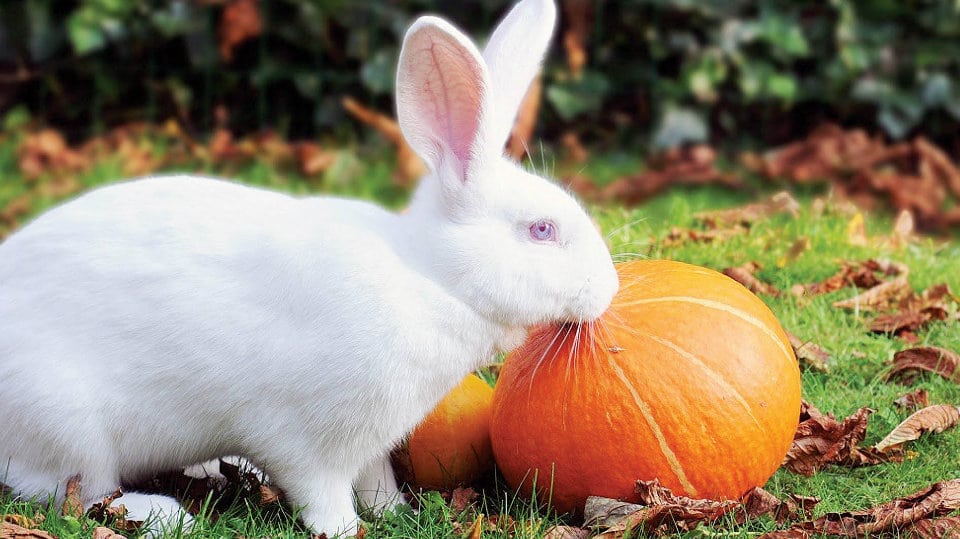In this week’s Pet Talk, Maneka tells about the treat alternatives for rabbits, other than veggies
By Maneka Gandhi
How long can rabbits go without eating?
Four hours. If your bunny is running around active and has access to his food dish, don’t assume he hasn’t eaten. A good way to be sure is to let them run on the floor (if it’s safe and they are used to it), and put out a little pile of food that you can keep an eye on over an hour or so. If the pile disappears (even slowly) as they run around happily, then they are eating. If however, the food doesn’t disappear, and your bunny is just sitting and ‘looking sick,’ then it’s better to be safe and take them to the vet.
Make sure your bunny is getting plenty of fresh greens and clean water. But, if you are ever unsure whether your rabbit is sick or not, always take them to the vet. Rabbits can go down hill very fast and, with a sick rabbit, every moment counts.
What are good treat alternatives for rabbits, other than veggies?
Other than the staple balanced diet that must be given to the rabbit, treats can be added to the diet. It is advised to give a large quantity of hay to the rabbits as a part of their daily diet. These treats can be safely added: • Rabbits love berries, like strawberries, raspberries and blackberries; • Little piece of carrot, or some celery; • Some herbs, like fresh basil, mint, thyme and rosemary; • Small quantities of banana; • Dandelions and milk thistles.
How do I pet my rabbit?
Rabbits like to be stroked on their forehead and cheeks. They like a good back scratch on the shoulders. They don’t like being touched on the ears, neck, feet, stomach and tail.
Wait till the rabbit has eaten. They are far more amenable to stroking after they have eaten.
If they are happy with what you are doing they put their head on the ground and close their eyes.
How common is cancer in older pets?
In pets the rate of cancer increases with age. Almost half of dogs over the age of 10 will develop cancer. Dogs get cancer at roughly the same rate as humans, while there is less information about the rate of cancer in cats. Some cancers, such as lymphoma, are more common in cats than in dogs. A diagnosis of cancer may be based on x-rays, blood tests, physical appearance of tumours, and other physical signs. The ultimate test for cancer is through confirmation via a biopsy.
Common signs of cancer in pets: • Abdominal swelling; • Bleeding from the mouth, nose or other body openings; • Difficulty breathing; • Difficulty eating; • Lumps, bumps or discoloured skin; • Non-healing wounds; • Persistent diarrhoea or vomiting; • Sudden changes in weight; • Unexplained swelling, heat, pain or lameness; • Visible mass/ tumour.
What are the common mistakes you make when feeding a cat?
• Give the cat too much food. Along with dry food, cats should only be fed two tablespoons of wet food two times a day.
• Feed a cat human food, but feeding a cat too much human food usually ends up with an overweight cat.
• Never serve your cat’s food in the same vicinity as his litter box.
• Place water at different parts of the house. They’ll consume more water if they find it in different locations around the house.
• Cat food has essential minerals, amino acids and fats that are essential for their good health. If you’re going to prepare your own, homemade cat food, you must add these essential supplements/ vitamins.
• Never serve your cat’s food, or water, in plastic. Plastic (even a good, stable quality plastic) is a very porous material and will absorb nasty odours over time.
What should I do if I have lost my pet?
Contact nearby shelters, animal control groups and rescue groups. And visit them daily. Shelters are very busy, and workers may not make the connection between found animals who are called in, or turned in, and your lost animal. Ask to see shelters’ lost and found records. Be persistent but polite, and don’t give up.
Make copies of the clearest photo you can find of your animal.
Plaster telephone poles with reward posters, and make your own super-huge signs to put in front of your house. Provide a reliable phone number and be available on that number all the time.
Use social media to spread information about your pet, include all important information regarding physical attributes, contact info, and a picture. Connect on animal welfare WhatsApp groups, Facebook groups, that work for animal welfare.
A pet shop near me is engaged in illegal breeding. What action can I take?
The Animal Welfare Board of India has released the new Dog Breeding, Marketing and Sales Rules in 2017. The rules mandate registration of all dog breeders with their respective State Animal Welfare Boards, and also lay definite requirements to be met by the breeders and the establishments used for breeding, or housing dogs, such as health-related requirements, housing facilities, manner of housing dogs, conditions for sale, breeding, micro-chipping, vaccination etc. Non-compliance of the rules will lead to cancellation of the registration of the dog breeder.
If you find an instance of violation of these rules, you should gather photographic evidence and report this matter to the Police, and register an FIR under the aforementioned Rules. After that, the Police will conduct an investigation on the basis of your report. If the Police are convinced that illegal breeding, as well as violation of the rules, is taking place, a charge sheet will be prepared and the case will go to court. It will result in cancellation of the licence of the dog breeder, as well as punishment for offences under Section 11 of the Prevention of Cruelty to Animals Act of 1960.
Recently, my cat has started drinking less water. Is that a problem?
In order to stay hydrated, your cat needs around-the-clock access to fresh drinking water. Keep her bowl clean and fill it regularly, especially if it’s placed near her food dish, as she may drop a few food crumbs into her drinking bowl.
Cats don’t actually need as much water as you might think. Their bodies actually require far less water than dogs, or other animals. Cats usually drink about an ounce of water for every half ounce of dry food they eat. Wet food, on the other hand, provides your kitty with food and moisture at once and can help her stay hydrated.
But, if your cat has suddenly started avoiding drinking water, then look at the cause of it.
In the absence of serious medical issues, start with the basics; is her water clear of food, hair, dust bunnies and other debris? Wash her bowl and replace her water at least once a day, if not more.
Some cats simply don’t like where their water dish is located. See if changing the placement of the bowl makes a difference. You can also keep water bowls at different places. A variety of bowl materials, like ceramic, metal and glass, may also encourage her to taste, test and investigate. Eating wet food will help to hydrate your cat. If your cat doesn’t care for canned food, you can add water to dry kibble, or combine wet and dry food in the same dish. Instead of giving heavy meals on fixed schedule, you can give smaller meals frequently during the day.
When a cat doesn’t consume enough water, she is at risk of dehydration. A cat can become dehydrated by not drinking enough water, or urinating more than she’s ingesting, or, in extreme situations, because of vomiting, or blood loss. Kidney disease, heat stroke and diabetes can all be related to dehydration. One easy way to identify dehydration in your cat is to check for loose skin, or “tenting.” Plop your cat into your lap and gently lift up the skin on the back of her neck. In a hydrated kitty, the flap of skin will snap back into place. If it stays up in a fold, or is slow to fall back, she likely needs more fluids.
Additional symptoms to watch out for include weakness, loss of appetite, panting, drooling, elevated heart rate, weak pulse, dry or sticky gums, trembling, excessive urination or infrequent urination.








Recent Comments